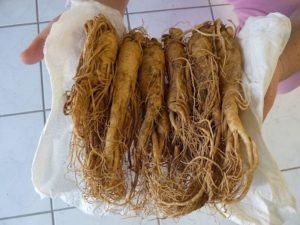
Three recent publications report results from transcriptome studies of plants often used for medicinal purposes, all powered by SMRT Sequencing and the Iso-Seq method. The papers on ginseng, Huangqi, and tea collectively show the importance of sequencing full-length isoforms for the most accurate and comprehensive gene expression analysis; they also demonstrate the usefulness of characterizing gene models for complex species in the absence of a reference genome assembly.
In “Isoform Sequencing Provides a More Comprehensive View of the Panax ginseng Transcriptome,” scientists from the National Institute of Horticultural and Herbal Science, Chungbuk National University, and other institutions in Korea describe efforts to characterize the functional genomics of P. ginseng. They studied four tissues (flower, leaf, stem, and root) from the ginseng plant, producing more than 135,000 assembled transcripts, averaging 3.2 kb in length. “We successfully identified unique full-length genes involved in triterpenoid saponin synthesis and plant hormonal signaling pathways, including auxin and cytokinin,” the team reports. “Transposable elements (TEs) were also identified, suggesting transcriptional activity of TEs in P. ginseng.” They also took a deep dive into 88 genes to assess alternative splicing. The scientists believe this work will facilitate the discovery of novel genes in this plant and its relatives, and suggest their results will be important for crop breeding programs.
Separately, scientists at the University of Adelaide in Australia and Shanxi University of Traditional Chinese Medicine in China published “Long read reference genome-free reconstruction of a full-length transcriptome from Astragalus membranaceus reveals transcript variants involved in bioactive compound biosynthesis.” A. membranaceus is also known as Huangqi and is a commonly used herb in Chinese medicine for cancers, diabetes, nephritis, and other diseases. The team studied transcriptomes of the plant’s leaf and root, identifying nearly 28,000 full-length, unique transcripts in leaf tissues and more than 22,000 in root tissues. “Compared with previous studies that used short read sequencing, our reconstructed transcripts are longer, and are more likely to be full-length and include numerous transcript variants,” the scientists report. Their analysis highlighted complex patterns of alternative splicing and enabled the detection of long-noncoding RNAs as well as characterization of biosynthesis genes. “Our study provides a practical pipeline to characterise the full-length transcriptome for species without a reference genome and a useful genomic resource for exploring the biosynthesis of active compounds in Astragalus membranaceus,” they conclude.
Finally, “Transcriptome Profiling Using Single-Molecule Direct RNA Sequencing Approach for In-depth Understanding of Genes in Secondary Metabolism Pathways of Camellia sinensis” comes from scientists at Anhui Agricultural University in China. They were investigating the biosynthesis of metabolites such as flavonoids and caffeine in this tea plant, performing Iso-Seq analysis of eight different tissues. The approach led to the identification of 94 full-length transcripts, plus four alternative splicing events, associated with the biosynthesis of the compounds of interest. “The longer reads improved the quality and accuracy of transcripts generated from [a previous] short-read assembly,” the scientists report. The new transcripts “provide a more accurate depiction of gene transcription and will greatly improve C. sinensis genome annotation in the future.”